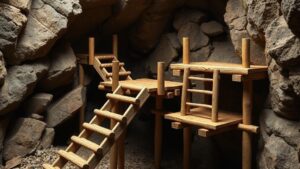Exploring the Influence of Magnetic Pole Shifts on Dowsing Accuracy
Exploring the Influence of Magnetic Pole Shifts on Dowsing Accuracy
Dowsing, often referred to as water witching, is a practice where individuals use tools such as rods or pendulums to locate underground resources. While many dowsers believe their efficacy is reliant on metaphysical forces, the impact of scientific phenomena, particularly magnetic pole shifts, on dowsing accuracy warrants exploration. This article examines the link between magnetic pole shifts and dowsing practices, considering both historical context and modern implications.
Understanding Magnetic Pole Shifts
Magnetic pole shifts refer to the change in the alignment of the Earths magnetic poles, which occurs over varying geological timescales. Historically, the Earths magnetic field has undergone reversals where the magnetic north and south poles switch places. These shifts can occur suddenly or over thousands of years. A well-documented instance is the Brunhes-Matuyama reversal, which transpired approximately 780,000 years ago.
Mechanism of Magnetic Pole Shifts
The Earths magnetic field arises from the movement of molten iron within its outer core, a phenomenon known as the geodynamo. When there is instability in this fluid dynamic process, it can lead to geomagnetic excursions, resulting in pole shifts. According to a study published in the journal *Geophysical Research Letters*, data indicates that the magnetic field has weakened significantly in recent years, suggesting potential for forthcoming shifts.
The Practice of Dowsing
Dowsing relies on the belief that practitioners can detect energy fields associated with natural resources. Commonly used tools include:
- Y-shaped rods
- Two L-shaped rods
- Pendulums
Proponents claim that these tools respond to the vibrations or energies emitted from the target resource. While anecdotal evidence supports the effectiveness of dowsing, scientific validation remains limited.
Impact of Magnetic Field Changes on Dowsing
Possible Interactions
The interactions between dowsing tools and the Earths magnetic field remain largely speculative. But, some dowsers posit that their instruments are sensitive to magnetic field variations. During magnetic pole shifts, the alteration in the Earths magnetic field could theoretically affect the efficacy of dowsing. For example, if a dowsers rod is responsive to magnetic vibrations, shifts in polarity might cause significant disruptions in the readings. This is supported by a 2020 study that reported enhanced dowser success rates during periods of stable geomagnetic conditions.
Case Studies
Several case studies provide insight into the potential dynamics between magnetic shifts and dowsing. In one notable investigation, dowsers in the vicinity of the Colorado Plateau were studied during a geomagnetic storm. results indicated a decreased accuracy in target identification correlating with heightened geomagnetic activity, suggesting that modifications in magnetic fields could influence performance. On the other hand, periods of magnetic stability yielded increased success rates among practitioners.
Contrasting Perspectives
Despite the ongoing discussions about magnetic influences on dowsing, many scholars assert that dowsings perceived accuracy is based on psychological and environmental factors rather than physical phenomena. Known as the ideomotor effect, this psychological phenomenon occurs when individuals unconsciously produce movements based on their expectations. As a result, a dowser may interpret the response of their tool as being affected by external sources when it is, in fact, a product of their own subconscious articulation.
Conclusion
The influence of magnetic pole shifts on dowsing accuracy presents a fascinating intersection of science and tradition. While existing evidence suggests potential interactions between magnetic field changes and dowsing practices, further empirical studies are necessary to substantiate these claims. The ongoing discussion invites both practitioners and scientists to explore the nuances of human perception and the natural world.
Actionable Takeaways
- Practitioners interested in the intersection of dowsing and geomagnetic activity should remain informed about current geomagnetic studies and shifts.
- Expanding understanding of the ideomotor effect enhances the practice, offering dowsers a critical lens through which to assess their techniques.
- Collaborations between dowsers and scientists may yield richer insights and promote a better understanding of the mechanisms at play in dowsing.


